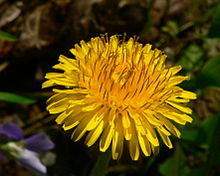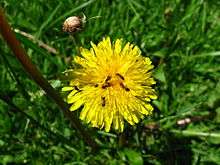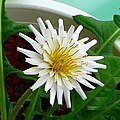Fix Our World
To Unite All People On a World Scale - Peace Environment Health Empowerment
Dandelions-NATURAL SOURCE OF VITAMINS
Taraxacum
| Dandelion | |
|---|---|
 |
|
 |
|
| A dandelion flower head composed of hundreds of smaller florets (top) and seed head (bottom) | |
| Scientific classification | |
| Kingdom: | Plantae |
| (unranked): | Angiosperms |
| (unranked): | Eudicots |
| (unranked): | Asterids |
| Order: | Asterales |
| Family: | Asteraceae |
| Tribe: | Cichorieae |
| Genus: | Taraxacum Cass. |
| Species | |
See text |
|
Taraxacum (![]() /təˈræksəkʉm/) is a large genus of flowering plants in the family Asteraceae. They are native to Eurasia and North America, and two species, T. officinale and T. erythrospermum, are found as weeds worldwide.[1] Both species are edible in their entirety.[2] The common namedandelion (/ˈdændɨlaɪ.ən/ dan-di-ly-ən, from French dent-de-lion, meaning lion's tooth) is given to members of the genus, and like other members of the Asteraceae family, they have very small flowers collected together into a composite flower head. Each single flower in a head is called a floret. Many Taraxacum species produce seeds asexually by apomixis, where the seeds are produced without pollination, resulting in offspring that are genetically identical to the parent plant.[3]
/təˈræksəkʉm/) is a large genus of flowering plants in the family Asteraceae. They are native to Eurasia and North America, and two species, T. officinale and T. erythrospermum, are found as weeds worldwide.[1] Both species are edible in their entirety.[2] The common namedandelion (/ˈdændɨlaɪ.ən/ dan-di-ly-ən, from French dent-de-lion, meaning lion's tooth) is given to members of the genus, and like other members of the Asteraceae family, they have very small flowers collected together into a composite flower head. Each single flower in a head is called a floret. Many Taraxacum species produce seeds asexually by apomixis, where the seeds are produced without pollination, resulting in offspring that are genetically identical to the parent plant.[3]
Contents[hide] |
[edit]Description
The species of Taraxacum are tap-rooted biennial or perennial herbaceous plants, native totemperate areas of the Old and New worlds.[clarification needed]
The leaves are 5–25 cm long or longer, simple and basal, entire or lobed, forming a rosette above the central taproot. The flower heads are yellow to orange coloured, and are open in the daytime but closed at night. The heads are borne singly on a hollow stem (scape) that rises 1–10 cm or more[4] above the leaves and exudes a milky sap (latex) when broken. A rosette may produce several flowering stems at a time. The flower heads are 2–5 cm in diameter and consist entirely of ray florets. The flower heads mature into spherical "clocks"[5] containing many single-seeded fruits called achenes. Each achene is attached to a pappus of fine hairs, which enable wind-aided dispersal over long distances.
The flower head is surrounded by bracts (sometimes mistakenly called sepals) in two series. The inner bracts are erect until the seeds mature, then flex downward to allow the seeds to disperse; the outer bracts are always reflexed downward. Some species drop the "parachute" from the achenes; the hair-like parachutes are called pappus, and they are modified sepals. Between the pappus and the achene, there is a stalk called a beak, which elongates as the fruit matures. The beak breaks off from the achene quite easily, separating the seed from the parachute.
[edit]Seed dispersal
A number of species of Taraxacum are seed dispersed ruderals that rapidly colonize disturbed soil, especially the Common dandelion (T. officinale), which has been introduced over much of the temperate world. After flowering is finished, the dandelion flower head dries out for a day or two. The dried petals and stamens drop off, the bracts reflex (curve backwards), and the parachute ball opens into a full sphere. Finally, the seed-bearing parachutes expand and lift out of it. The parachute drops off the achene when it strikes an obstacle[citation needed]. After the seed is released, the parachutes lose their feathered structure and take on a fuzzy, cotton-like appearance, often called "dandelion snow"[citation needed].
[edit]False dandelions
Dandelions are so similar to catsears (Hypochaeris) that catsears are also known as "false dandelions". Both plants carry similar flowers, which form into windborne seeds. However, dandelion flowers are borne singly on unbranched, hairless and leafless, hollow stems, while catsear flowering stems are branched, solid and carry bracts. Both plants have a basal rosette of leaves and a central taproot. However, the leaves of dandelions are smooth or glabrous, whereas those of catsears are coarsely hairy.
Other plants with superficially similar flowers include hawkweeds (Hieracium) and hawksbeards(Crepis). These are readily distinguished by branched flowering stems, which are usually hairy and bear leaves.
[edit]Classification
The genus is taxonomically complex, with some botanists dividing the group into about 34 macrospecies, and about 2000 microspecies;[6] approximately 235 apomictic and polyploidmicrospecies have been recorded in Great Britain and Ireland.[7] Some botanists take a much narrower view and only accept a total of about 60 species.[6]
[edit]Selected species
- Taraxacum albidum, a white-flowering Japanese dandelion.
- Taraxacum californicum, the endangered California dandelion
- Taraxacum japonicum, Japanese dandelion. No ring of smallish, downward-turned leaves under the flowerhead.
- Taraxacum kok-saghyz, Russian dandelion, which produces rubber[8]
- Taraxacum laevigatum, Red-seeded Dandelion; achenes reddish brown and leaves deeply cut throughout length. Inner bracts' tips are hooded.
- Taraxacum erythrospermum, often considered a variety of Taraxacum laevigatum.[9]
- Taraxacum officinale (syn. T. officinale subsp. vulgare), Common Dandelion. Found in many forms.
[edit]Cultivars
- 'Amélioré à Coeur Plein' - Yields an abundant crop without taking up much ground, and tends to blanch itself naturally, due to its clumping growth habit.
- 'Broad Leaved' - The leaves are thick and tender and easily blanched. In rich soils they can be up to 60 cm wide. Plants do not go to seed as quickly as French types.
- 'Vert de Montmagny'- Long dark green leaves, some find them mild enough to be palatable without blanching. Vigorous and productive.[10]
[edit]History
| This section requires expansion. |
Dandelions are thought to have evolved about thirty million years ago in Eurasia.[11] They have been used by humans for food and as a herbfor much of recorded history.[12] They were introduced to North America by early European immigrants.
[edit]Origin of the names
The Latin name taraxacum originates in medieval Arabic writings on pharmacy. Al-Razi around 900 (A.D.) wrote "the tarashaquq is like chicory". Ibn Sīnā around 1000 (A.D.) wrote a book chapter on taraxacum. Gerard of Cremona, in translating Arabic to Latin around 1170, spelled it tarasacon.[13]
The English name dandelion is a corruption of the French dent de lion[14] meaning "lion's tooth", referring to the coarsely toothed leaves. The names of the plant have the same meaning in several other European languages, such as the Welsh dant y llew, Italian dente di leone, Catalan dent de lleó, Spanish diente de león, Portuguese dente-de-leão, Norwegian Løvetann, Danish Løvetand and German Löwenzahn.
In modern French, the plant is named pissenlit (or vernacular pisse au lit).[citation needed] Likewise, "piss-a-bed" is an English folk-name for this plant,[15] as are piscialletto in Italian, pixallits in Catalan and meacamas in Spanish.[citation needed] These names refer to the strongdiuretic effect of the plant's roots,[15] either roasted or raw. In various north-eastern Italian dialects, the plant is known as pisacan ("dog pisses"), because they are found at the side of pavements.[16]
In France, it is also known as laitue de chien (dog's lettuce), salade de taupe (mole's salad), florin d'or (golden florin); cochet (cockerel);fausse chicorée (false chicory); couronne de moine (monk's crown); baraban.[citation needed]
In several European languages the plant, or at least its parachute ball stage, is named after the popular children's pastime of blowing the parachutes off the stalk: Pusteblume German for "blowing flower"), soffione (Italian for "blowing", in some northern Italian dialects),[16]dmuchawiec (Polish, derived from the verb "blow"), одуванчик (Russian, derived from the verb "blow").[citation needed]
In other languages, the plant is named after the white sap found in its stem, e.g. mlecz (derived from the Polish word for "milk"), mælkebøtte(Danish for "milk pot"), kutyatej (Hungarian for "dog milk"), маслачак (Serbian, from маслац meaning "butter").[citation needed] The Lithuanianname kiaulpienė can be translated as "sow milk"[citation needed]. Similarly, in Latvian it is called pienene, derived from piens ('milk'), as inCatalan is used lletsó (derived from the word llet that means "milk").[citation needed]
The alternative Hungarian name gyermekláncfű ("child's chain grass") refers to the habit of children to pick dandelions, remove the flowers, and make links out of the stems by "plugging" the narrow top end of the stem into the wider bottom end.[citation needed]
In Bulgarian and Macedonian its name (respectively глухарче and глуварче) is derived from the word for 'deaf' (глух, глув), because of a traditional belief that dandelion parachutes can cause deafness.
In Turkish, the dandelion is called karahindiba meaning "black endive".[citation needed] While the root flesh is white, the outer skin of the root is dark brown or black.
In Swedish, it is called maskros ('worm rose') after the small insects (thrips) usually present in the flowers.[17]
In Finnish and Estonian, it is called voikukka and võilill, respectively, meaning "butter flower", referring to its buttery colour.[citation needed]Similarly, in Croatian, the name of this plant (maslačak) is derived from the noun maslac, meaning butter.[18]
In Dutch it is called paardenbloem, meaning "horse-flower".
In Chinese it is called pú gōng yīng (蒲公英), meaning "flower that grows in public spaces by the riverside".[citation needed] In Japanese, it istanpopo (タンポポ?).
In Persian it is called qasedak (قاصدک), meaning the "small postman", because of a belief that it brings good news.
In Portuguese it is called dente-de-leão, also meaning "lion's tooth". Portuguese children also call them "o teu pai é careca" (your dad is bald) due to a game which consisted on blowing on a dandelion. If it was left with no seeds, that would mean the other kid's dad was bald.
In Greek its seed (and most often the plant itself) is called a kleftis (κλέφτης) meaning "thief" because it is very difficult to catch once airborne.
[edit]Properties
[edit]As a beneficial weed
The dandelion plant is a beneficial weed, with a wide range of uses, and is even a good companion plant for gardening. Its taproot will bring up nutrients for shallower-rooting plants, and add minerals and nitrogen to soil. It is also known to attract pollinating insects and release ethylene gas which helps fruit to ripen.[19]
[edit]Culinary use
| Nutritional value per 100 g (3.5 oz) | |
|---|---|
| Energy | 188 kJ (45 kcal) |
| Carbohydrates | 9.2 g |
| - Sugars | 0.71 g |
| - Dietary fiber | 3.5 g |
| Fat | 0.7 g |
| - saturated | 0.17 g |
| Protein | 2.7 g |
| Water | 85.6 g |
| Vitamin A equiv. | 508 μg (64%) |
| - beta-carotene | 5854 μg (54%) |
| - lutein and zeaxanthin | 13610 μg |
| Thiamine (vit. B1) | 0.19 mg (17%) |
| Riboflavin (vit. B2) | 0.26 mg (22%) |
| Niacin (vit. B3) | 0.806 mg (5%) |
| Pantothenic acid (B5) | 0.084 mg (2%) |
| Vitamin B6 | 0.251 mg (19%) |
| Folate (vit. B9) | 27 μg (7%) |
| Choline | 35.3 mg (7%) |
| Vitamin C | 35.0 mg (42%) |
| Vitamin D | 0.0 μg (0%) |
| Vitamin E | 3.44 mg (23%) |
| Vitamin K | 778.4 μg (741%) |
| Calcium | 187 mg (19%) |
| Iron | 3.1 mg (24%) |
| Magnesium | 36 mg (10%) |
| Manganese | 0.342 mg (16%) |
| Phosphorus | 66 mg (9%) |
| Potassium | 397 mg (8%) |
| Sodium | 76 mg (5%) |
| Zinc | 0.41 mg (4%) |
| Percentages are relative to US recommendations for adults. Source: USDA Nutrient Database |
|
Dandelions are found on all continents and have been gathered since prehistory, but the varieties cultivated for consumption are mainly native to Eurasia. Aperennial plant, its leaves will grow back if the taproot is left intact. To make leaves more palatable, they are often blanched to remove bitterness.[12] Dandelion leaves and buds have been a part of traditionalSephardic, Chinese and Korean cuisine. In Crete,Greece, the leaves of a variety called Mari (Μαρί), Mariaki (Μαριάκι) or Koproradiko (Κοπροράδικο) are eaten by locals, either raw or boiled, in salads. Another species endemic to Crete, is eaten in the same way; it is found only at high altitudes (1000 to 1600 m.) and in fallow sites, and is called pentaramia (πενταράμια) or agrioradiko (αγριοράδικο) and which has been named Taraxacum megalorhizon by Prof. Michalis Damanakis of the Botanics Department of the University of Crete.[20]
The flower petals, along with other ingredients, are used to make dandelion wine. The ground, roasted roots can be used as a caffeine-free dandelion coffee.[21] Dandelion was also traditionally used to make the traditional British soft drink dandelion and burdock, and is one of the ingredients of root beer.
Dandelion leaves contain abundant vitamins and minerals, especially vitamins A, C and K, and are good sources of calcium, potassium, iron and manganese.[22]
[edit]Traditional uses
Historically, dandelion was prized for a variety of medicinal properties, and it contains a wide number of pharmacologically active compounds.[23] Dandelion is used as folk remedies in Europe, North America and China.[23] It was used to treat infections, bile and liver problems,[23]as well as cancers,[citation needed] and as a diuretic.[23] There is evidence to suggest it may haveanti-inflammatory effects and assist with urinary tract infections in women.[citation needed]Dandelion pollen may cause allergic reactions when eaten, or adverse skin reactions in sensitive individuals. Due to its high potassium level, dandelion may also increase the risk ofhyperkalemia when taken with potassium-sparing diuretics.[24]
[edit]Insects
Dandelions are important plants for northern hemisphere bees, providing an important source of nectar and pollen early in the season.[25] Dandelions are used as food plants by the larvae of some species of Lepidoptera (butterflies and moths). See List of Lepidoptera that feed on dandelions. They are also used as a source of nectar by the pearl-bordered fritillary (Boloria euphrosyne), one of the earliest emergingbutterflies in the spring.

[edit]Culture
Four dandelion flowers are the emblem of White Sulphur Springs, West Virginia.[26] The citizens celebrate spring with an annual Dandelion Festival.
The dandelion is the official flower of the University of Rochester and "Dandelion Yellow" is one of the school's official colors. The Dandelion Yellow is an official University of Rochester song.[27]
[edit]See also
- Dandelion and burdock
- Dandelion coffee
- List of beneficial weeds
- List of companion plants
- Medicinal properties of dandelion
[edit]References
- ^ "Taraxacum". Flora of North America.
- ^ "Wild About Dandelions". Mother Earth News.
- ^ Dandelion - J. Doll and T. Trower [dead link]
- ^ Taraxacum in Flora of North America @ efloras.org
- ^ "Dandelion Clock - Definition from Longman English Dictionary Online". Ldoceonline.com. Retrieved 2010-07-03.
- ^ a b Richards, A.J. (1970). Eutriploid facultative agamospermy in Taraxacum. New Phytologist. 69(3): 761–774 plate.
- ^ Richards, A.J. (1997). Dandelions of Great Britain and Ireland (Handbooks for Field Identification). BSBI Publications. p. 330.ISBN 978-0901158253.
- ^ "Plants for a future: Taraxacum kok-saghiz".
- ^ Flora of North America
- ^ Edible Plants
- ^ Gardening in Western Washington: Dandelions
- ^ a b McGee, Harold (2004). On Food and Cooking: the science and lore of the kitchen. New York: Scribner. pp. 320. ISBN 0-684-80001-2.
- ^ Reported in An Etymological Dictionary of the English Language, by Walter W. Skeat (1888) (Downloadable at Archive.org). In An Etymology Dictionary of Modern English by Ernest Weekley (1921) it is reported that Arabic tarashaqun is derivable in turn from Persian talkh chakok, bitter herb (Downloadable at Archive.org).
- ^ S. Potter & L. Sargent (1973) Pedigree: essays on the etymology of words from nature. Collins New Naturalist series Volume 56
- ^ a b Taylor, Joseph (1819). Antiquitates curiosae: the etymology of many remarkable old sayings, proverbs and singular customs explained by Joseph Taylor (2nd ed.). T&J Allman. p. 97.
- ^ a b Anon. "Dandelion - far more than a weed". Frapez.com. Frapez soothie spa. Retrieved 30 May 2010.
- ^ "Den virtuella floran: Taraxacum F. H. Wigg. - Maskrosor" (in Swedish). Linnaeus.nrm.se. Retrieved 2010-07-03.
- ^ hjp.srce.hr (Croatian Language Portal)
- ^ Anon. "Companion Planting for Vegetables & Plants". Country living and farm lifestyles. countryfarm-lifestyles.com. Retrieved 2011-03-07.
- ^ Kleonikos G. Stavridakis , Κλεόνικος Γ. Σταυριδάκης (2006). Wild edible plants of Crete - Η Άγρια βρώσιμη χλωρίδα της Κρήτης. Rethymnon Crete. ISBN 960-631-179-1.
- ^ Castronovo Fusco, MA (2008-04-15). "Dandelion as underrated as underfoot". New Jersey On-Line. Retrieved 2011-03-07.
- ^ "Dandelion greens, raw". Nutritiondata.com. nd. Retrieved 2011-03-07.
- ^ a b c d Schutz, K.; Carle, R.; Schieber, A. (2006). "Taraxacum—A review on its phytochemical and pharmacological profile". Journal of Ethnopharmacology 107 (3): 313–323.doi:10.1016/j.jep.2006.07.021. PMID 16950583. edit
- ^ Rodriguezfragoso, L; Reyesesparza, J; Burchiel, S; Herreraruiz, D; Torres, E (2008). "Risks and benefits of commonly used herbal medicines in Mexico". Toxicology and Applied Pharmacology227 (1): 125–135. doi:10.1016/j.taap.2007.10.005. .PMID 18037151. edit
- ^ Pellett, Frank Chapman (1920). American Honey Plants; Together With Those Which Are of Special Value to the Beekeeper as Sources of Pollen. American Bee Journal Publication. p. 178.ISBN 1152862715.
- ^ "Welcome to Main Street White Sulphur Springs...Make it home". Wssmainstreet.org. Retrieved 2010-07-03.
- ^ "Songs of the University of Rochester". Lib.rochester.edu. 2010-01-14. Retrieved 2010-07-03.
Tags:
Replies to This Discussion
Blog Posts
© 2025 Created by FixOurWorld.
Powered by
![]()







